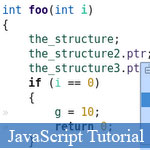 This JavaScript article tutorial guides you how to check type of JavaScript variables. This JavaScript tutorial guide contains full-completed JavaScript example codes and comments, it's very easy to follow, please go to the full-post page for details.
This JavaScript article tutorial guides you how to check type of JavaScript variables. This JavaScript tutorial guide contains full-completed JavaScript example codes and comments, it's very easy to follow, please go to the full-post page for details.
Other JavaScript tutorials for beginners:
- JavaScript OOP Tutorial for Dummies
- 10 Tiny JavaScript Snippets for Good Beginners
- Top 10 Best JavaScript eBooks that Beginners should Learn
- The basics of Javascript for beginners
- Demo
- Enlarge
- Reload
- New window
Free iPage Web Hosting for First Year NOW
If you're still looking for a reliable web host provider with affordable rates, why you don't take a little of time to try iPage, only with $1.89/month, included $500+ Free Extra Credits for the payment of 24 months ($45)?
Over 1,000,000+ existisng customers can not be wrong, definitely you're not, too! More important, when you register the web hosting at iPage through our link, we're going to be happy for resending a full refund to you. That's awesome! You should try iPage web hosting for FREE now! And contact us for anything you need to know about iPage.
foo versus window.foo and this.foo
The secret to our solution lies in how JavaScript handles undefined variables versus undefined properties. Here’s a quick reminder on the difference between the two:
// variable foo
var foo;
// property bar (and object variable foo)
var foo = {}; // create an empty object to add bar too
foo.bar = "";
The difference between these makes all the difference whether a fatal error occurs:
foo; // ReferenceError: foo is not defined
var foo = {};
foo.bar; // undefined
foo.blah; // undefined
We can randomly invent and check any property of foo we want, and the code will keep chugging along:
var foo = {};
foo.something = "hello";
if(foo.bar) { // undefined, interpreted as false (same as !!foo.bar)
// never runs
}
if(foo.something) {
foo.something; // "hello"
}
Now comes the magic. If you know anything about JavaScript running
in the browser, you know that all global variables are part of the window object. This means foo and window.foo are equivalent:
var foo; foo === window.foo; // true // "this" is another bag of worms, but note this anyway this.foo === window.foo;
So technically our variable foo is a property of the window object. So we should be able to check for any arbitrary variable in the window scope now!
window.foo; // undefined (not a fatal error!) // even though we're checking for the same thing, we get a fatal error… foo; // ReferenceError: foo is not defined
Practical uses
Now as long as we have a global entry point for our code, we can write our code in such a way that it won’t ever give us a fatal error if our variables aren’t yet defined:
if(window.foo && foo.bar) {
foo.bar();
}
Of course nothing happens, because we haven’t defined foo. But why
doesn’t foo.bar give us a fatal error? Because the first test, window.foo
failed out. It would be useless processing for the JavaScript engine
to also evaluate the second statement, because the end result will still
be the same (false && true results in false, false &&
false results in false). So it doesn’t get so far as foo.bar.
And now the code will work properly when we hook up our code to our foo global namespace:
var foo = {
bar: function() {
alert("hello world");
}
}
if(window.foo && foo.bar) {
foo.bar(); // "hello world"
}
Shorthand
It’s becoming common to see an abbreviation for the above code. Check out the following two methods, which accomplish the same thing:
// Method 1
if(window.foo && foo.bar) {
foo.bar(); // "hello world"
}
// Method 2
window.foo && foo.bar && (foo.bar());
Don’t get too scared.. these blocks of code are equivalent. Method 2
is shorter, but it simply goes something like this: if window.foo isn’t
set, stop evaluating this line (just as above in the if statement). Otherwise, if foo.bar exists then execute the code in parentheses, which gives us an alert (“hello world”);
Just a word of caution about using Method 2: it’s obviously less clear what’s going on here. Your own cleverness might actually result in unnecessary confusion, especially of other people work in the same code base and they’re at different levels of understanding. In these cases we should first strive to be clear, and then only clever if it’s not at the expense of being clear.
It’s also likely that a code minifier would take care of this cleverness for us at build time, giving us the best of both worlds.
- Sent (0)
- New
Save up to 630$ when buy new iPhone 15
GateIO.gomymobi.com
Free Airdrops to Claim, Share Up to $150,000 per Project
https://tooly.win
Open tool hub for free to use by any one for every one with hundreds of tools
chatGPTaz.com, chatGPT4.win, chatGPT2.fun, re-chatGPT.com
Talk to ChatGPT by your mother language
Dall-E-OpenAI.com
Generate creative images automatically with AI
AIVideo-App.com
Render creative video automatically with AI






 16/06/2011
16/06/2011 0
0
